Huawei Technologies U1215 WCDMA/GPRS/GSM/EDGE Mobile Phone with Bluetooth User Manual U121
Huawei Technologies Co.,Ltd WCDMA/GPRS/GSM/EDGE Mobile Phone with Bluetooth U121
Contents
- 1. User Manual Part 1
- 2. User Manual Part 2
User Manual Part 2

15
4Text Input
You can use the keypad to enter alphanumeric char-
acters and symbols. For example, you can add
entries to the contacts, write messages or schedule
events on the calendar.
Note
While entering text:
• Press to switch between input meth-
ods, including "abc", "Abc", "ABC", and
numbers.
• Press to enable or disable T9 input
method.
• Press to display the commonly-used
symbols list. You can use the scroll keys
to select.
• Press to delete the letter before the cur-
sor.
T9 Input Method
With the T9 input method, you can easily and quickly
enter words with predictive text scheme.
• Press each key carrying the desired letter once,
and then the predictive text scheme will present the
candidate words composed by the letters you have
entered in the drop-down menu.
• After entering all letters, if there is not the expected
one in the drop-down menu, you can select [Spell]
to enter the desired letter using the traditional input
method and then select Insert. The words you
inserted will be saved in the predictive text dictio-
nary. If the dictionary is full, the new word replaces
the oldest one.
For example, to enter the word "good" with the T9
input method, follow these steps.
1Press successively the keys , , , and
which "g", "o", "o", and "d" belong to, and the
candidate words composed by these letters will
be shown in the drop-down menu.
2Use the up/down scroll key to select "good".
Note
Press repeatedly and you will see "T9
abc", "T9 Abc" and "T9 ABC" on the upper
left corner of the screen successively. It indi-
cates the words to be entered will be in
lower case, first letter capitalized or in upper
case.
U121.book Page 15 Friday, October 19, 2007 10:40 AM

Traditional Input Method
16
Traditional Input Method
When T9 input method is off, you can use the tradi-
tional input method for entering alphabetic charac-
ters. Repeatedly press the key that carries the letter
to be entered when it appears on the screen.
For example, to enter the word "Hello" with the tradi-
tional input method, follow these steps.
1Press that carries "h" repeatedly and all let-
ters carried by this key will be displayed succes-
sively on the screen. Stop when you see an "h"
on the screen.
2After entering the first letter, you can directly
press another key (except ) to enter the next
letter. If the next desired letter is on the same
key as the current one, wait until the cursor
appears to the right of the current letter and then
you can enter the next one.
3Enter "e", "l", "l" and "o" in the same way.
Note
• Press repeatedly and you will see
"abc", "Abc" or "ABC" on the upper left
corner of the screen successively. It indi-
cates the words to be entered will be in
lower case, first letter capitalized or in
upper case.
• Press and hold number keys to enter
numbers.
"123" Numeric Input Method
With the "123" numeric input method, you can enter
corresponding numeric characters by pressing the
character/number keys. For example, to enter "1"
with the "123" numeric input method, you can
press . Then "1" appears on the screen.
Symbol Input Method
Your phone provides an independent symbol input
method. For example, to enter ":" with the symbol
input method, you can just press the scroll keys to
select ":" in the symbol list and then press .
U121.book Page 16 Friday, October 19, 2007 10:40 AM

Input Different Languages
17
Text Input
4
Input Different Languages
In a text editing screen, select Options > Input
language to set the language for the text. The
selected language will be displayed on the upper
middle part of the editing screen.
U121.book Page 17 Friday, October 19, 2007 10:40 AM
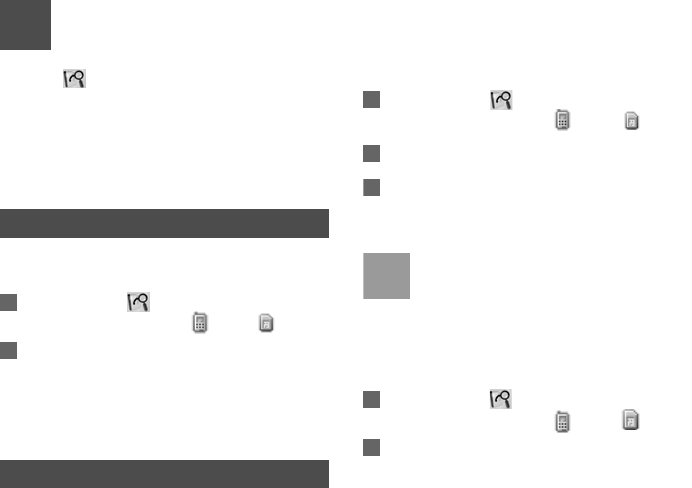
18
5Contacts
Contacts enables you to save and manage such
information as phone numbers and addresses of your
contacts. You can save such information in your
phone or your SIM card. You can also assign fre-
quently-used numbers to speed dialing keys for your
convenience.
Making Calls from the Contacts
You can make a voice/video call with a contact
selected from the contacts list.
1In the Contacts screen, press the left/right
scroll key to select Phone or SIM .
2Select a contact and select Options > Call.
Then, you can select Voice Call or Video Call to
make a call. Alternatively, you can select Edit
before call to edit the number before making the
call.
Searching for a Contact
You can find a contact from the contacts list easily
and quickly by using this function on both the Phone
screen and the SIM screen.
1In the Contacts screen, press the left/right
scroll key to select Phone or SIM .
2Select Options > Search.
3Select Options > Search, and then enter the
contact name you are searching for. The contact
is displayed.
Note
The search result includes all matched con-
tacts from both the phone and SIM memo-
ries, regardless of the screen (Phone or
SIM) from which you start searching.
You can also use quick search in the Phone or SIM
screen:
1In the Contacts screen, press the left/right
scroll key to select Phone or SIM .
2Enter a string (one or more letters or numbers)
contained in the contact name you are searching
for. Then the contacts whose names contain this
string are displayed.
U121.book Page 18 Friday, October 19, 2007 10:40 AM
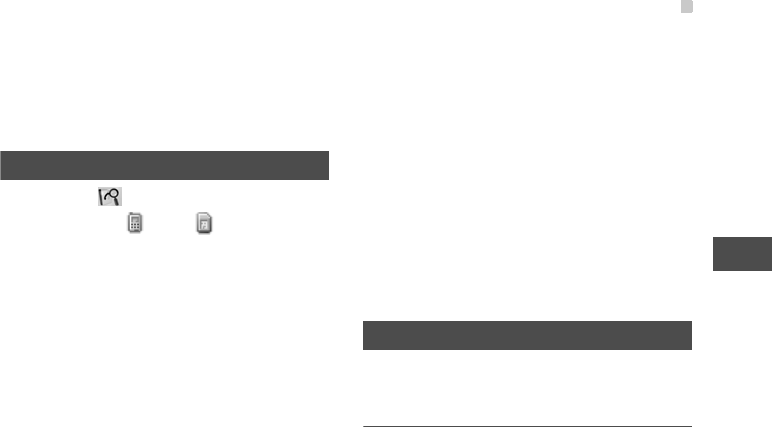
Other Operations
19
5
Contacts
You can also find a contact by entering the initials of
the first name and the last name of the contact. For
example, to find a contact named "Alice Green",
enter the initials "ag". This contact is displayed in the
candidate list.
Other Operations
In the Contacts screen, press the left/right scroll
key to select Phone or SIM .Then select
Options for the following options.
• Details: To view the details of contact.
• Create message: To send a message, MMS or
Email to the selected contact.
• New: To create a new contact.
• Send contact: To send a contact to other devices
supporting SMS or Bluetooth.
• Copy to SIM/Copy to phone: To Copy one or more
contacts from your phone to the SIM card or from
your SIM card to the phone.
• Speed Dial Number: To assign often-used numbers
to speed dialing keys "2" to "9".
• My business card: To save your own information to
a Business Card. You can send the information by
SMS or Bluetooth.
• Backup contacts: To back up your contacts from
your phone to a memory card or from your memory
card to your phone.
• Delete: To delete the selected contact.
• Mark/Unmark: To mark/unmark a record or all
records in your phone and SIM card.
• Memory status: To view the memory status of both
your phone and SIM card.
• Settings: To sort the contacts in the phone and the
SIM card or to set an alert before saving.
Groups
You can rename a group, add group members, or
delete a group.
Adding/Deleting Group Members
You can add a member to a group in your phone or
delete a member from it.
U121.book Page 19 Friday, October 19, 2007 10:40 AM
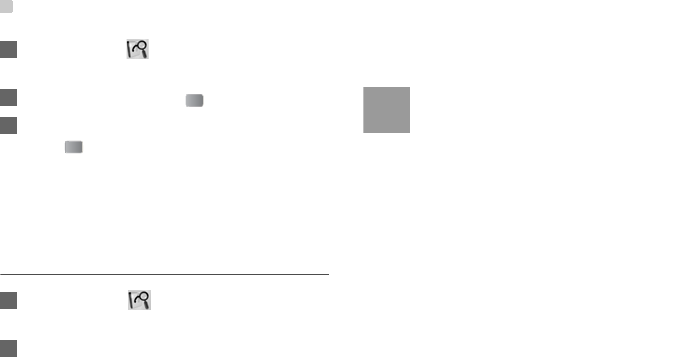
Groups
20
1In the Contacts screen, press the left/right
scroll key to select Groups.
2Select a group and press to view the details.
3Select Options > Add. Select a contact and
press . The member you added is displayed
in the group member list.
To delete a group member, select a member from the
group member list, and then select Options >
Delete.
Managing a Group
1In the Contacts screen, press the left/right
scroll key to select Groups.
2Select a group and select Options for the follow-
ing options.
• Details: to view the details of a group.
• Rename: to change the name of a group.
• Create message: to send a text message or
MMS to all members of a group.
• Delete: to delete a group and all members of
the group.
Note
You cannot rename or delete any group pre-
set in your phone.
U121.book Page 20 Friday, October 19, 2007 10:40 AM
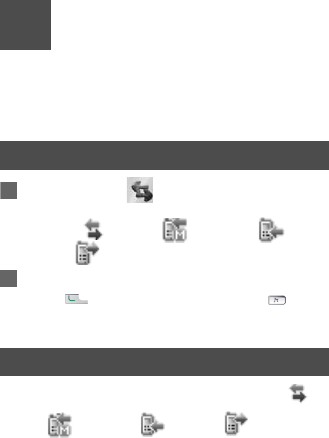
21
6Call Log
The recently dialed calls, received calls and missed
calls are saved automatically. This makes it easier to
refer to these calls.
Making Calls from Call Log
1Select Call Log in the main menu and then
press the left/right scroll key to switch between
All calls , Missed , Received and
Dialed .
2Press the up/down scroll key to select a record.
Press to make a voice call or press to
make a video call.
Other Operations
Press the left/right scroll key to select All calls ,
Missed , Received or Dialed . Then select
Options for the following options.
• Edit before call: To edit the number before making
the call.
• Create message: To send a message or MMS.
• Save number: To save the numbers of the selected
record to the phone, the SIM card, or an existing
contact.
• Call: To make a voice call or a video call.
• Display mode: You can select Normal to display all
records or select Simple to ignore the duplicated
records.
• Delete: To delete the selected record.
• Mark/Unmark: To mark/unmark a record or all
records.
• Calls status: To display the information on voice
calls, video calls and data services. In the voice
call, video call and data page, you can select Reset
to clear all records.
U121.book Page 21 Friday, October 19, 2007 10:40 AM
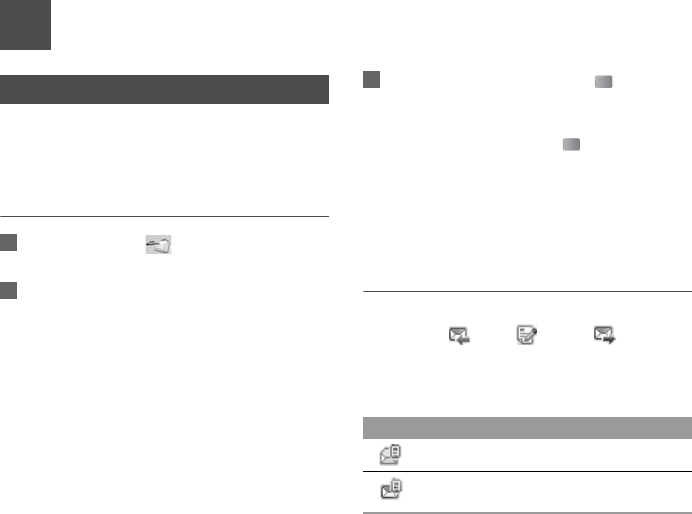
22
7Messaging
Text Messages
The maximum content for a single text message is
160 English letters. If the characters you enter
exceed this limit, the text is divided into two or more
continuous messages when it is sent.
Creating a Text Message
1Select Messaging > Write SMS in the main
menu.
2In the message editing screen, select Options:
• Send:To send the message.
• Insert number: You can insert a phone number
saved on the phone or the SIM card.
• Common phrases: You can use these to speed
up the process of entering text.
• T9 Switch: You can select this option to enable
or disable T9 input method.
• Input mode: You may select one of the input
methods to enter the message contents.
• Input language: You can select a language for
this message.
3After editing the message, press to access
the "Edit numbers" screen.
• Enter the phone number, and then select
Options > Send or press to send the mes-
sage.
• Select Options > Group or Contacts to
choose a number and send the message.
• Select Options > Save to drafts to save the
message.
SMS Mailboxes
The phone provides three mailboxes for SMS,
namely, Inbox , Drafts and Sent .
◆ Inbox
You can save the received messages in Inbox.
Icons in Inbox
Icon Description
a read message in the phone memory
an unread message in the phone mem-
ory
U121.book Page 22 Friday, October 19, 2007 10:40 AM
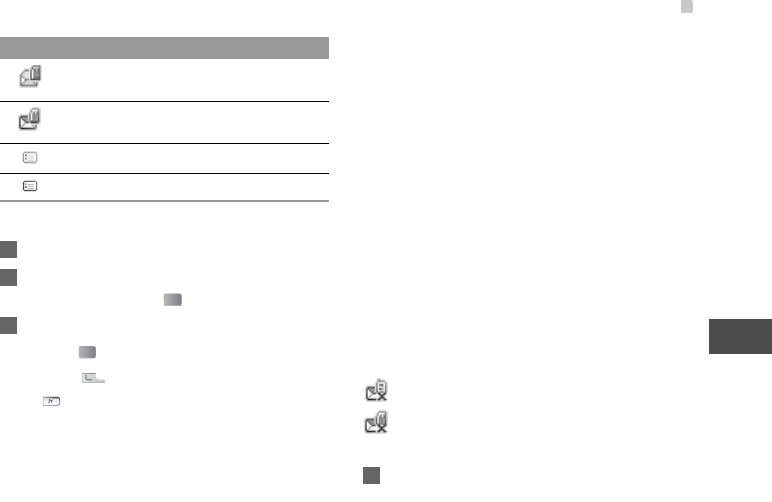
Text Messages
23
Messaging
7
Viewing Messages in Inbox
1Select Messaging > SMS > Inbox.
2Press the up/down scroll key to view the mes-
sages and then press to view the details.
3Reply or call back.
• Press to reply with a text message.
• Press to call back by a voice call or press
to call back with a video call.
You can select Options for the following operations.
• Reply: To reply the message.
• Forward: To forward the message.
• Edit before call: To edit the number before making
the call.
• Save number: To save the numbers retrieved from
an SMS to phone or SIM memory or an existing
entry in the contacts.
• Extract URL: To extract URL address from an SMS
for browsing web pages or stream media.
• Save Email address: To retrieve email address from
an SMS and save it.
• Copy to SIM: To back up the SMS to SIM memory.
• Call: To make a voice call or a video call.
• Delete: To delete the message.
◆ Drafts
The Draft box is used to save the messages you cre-
ated and saved and those which failed to send.
Icons in Drafts
: A text message saved to the phone.
: A text message saved to the SIM card.
Viewing and Editing Messages in the Draft
1Select Messaging > SMS > Drafts.
a read message on the SIM card mem-
ory
an unread message on the SIM card
memory
a read message report
an unread message report
Icon Description
U121.book Page 23 Friday, October 19, 2007 10:40 AM
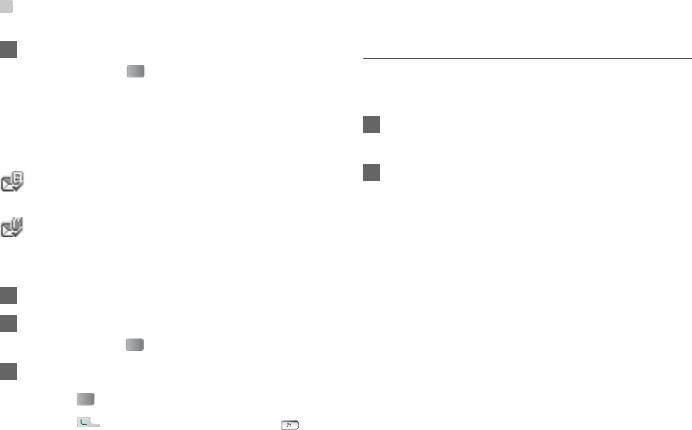
Text Messages
24
2Press the up/down scroll key to select a mes-
sage and press to edit it.
◆ Sent
Sent is used to save the messages that have been
sent.
Icons in Sent
: A text message that has been sent and saved to
the phone.
: A text message that has been sent and saved to
the SIM card.
Viewing Messages in the Sent
1Select Messaging > SMS > Sent.
2Press the up/down scroll key to select a mes-
sage and press to view the details.
3Forward or make a call.
• Press to forward a text message.
• Press to make a voice call or press to
make a video call.
You may select Options to do the same operations
as those of SMS Inbox.
SMS Settings
You can change the SMS settings by performing the
following steps.
1Select Messaging > Settings > SMS from the
main menu.
2Set the parameters related to messages:
• Message center: The Phone can auto read the
number of the message centre from the SIM
card or the handset. If you have deleted the
information by accident, contact your service
provider.
• Valid period: The time a message is kept in the
message centre after it is sent.
• Auto save: You can set whether a message will
be saved automatically to Sent when it is sent.
• Save to: To set the position for saving newly
created messages, received messages, and
sent messages.
• Signature: To set whether your signature will
be sent along with the message. You can edit
the signature while creating a new message.
U121.book Page 24 Friday, October 19, 2007 10:40 AM
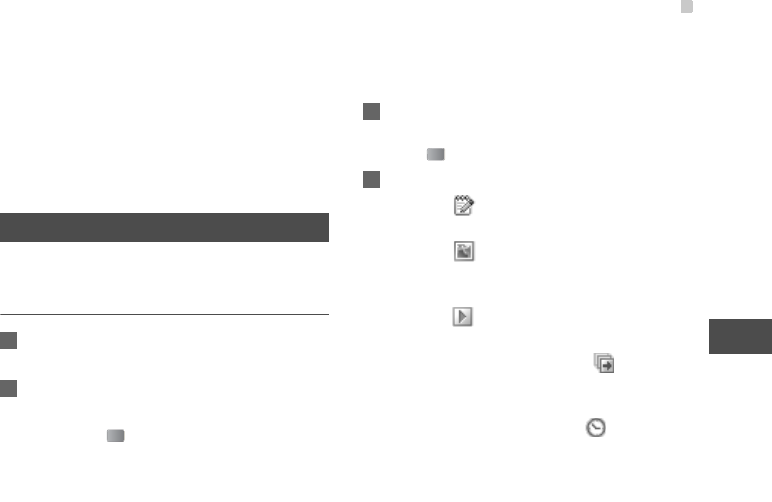
Multimedia Messages
25
Messaging
7
• Status report: You can set it to On or Off. If you
set it to On, the network sends you a status
report indicating whether the SMS has reached
the recipient or not.
• Concatenated SMS: You can set it to On or
Off. If you set it to Off, you cannot edit and
send messages longer than the limit of a single
SMS.
Multimedia Messages
You can send messages attached with images, text
and music under this mode.
Creating a Multimedia Message
1Select Messaging > Write MMS from the main
menu.
2Select To, Cc or Bcc.
• Select an entry from the recipients list, and
then press or select Options > Edit to enter
a phone number.
• Select a position from the recipients list, select
Options > Contact or Group, and then select
phone numbers.
3Select Back to return to the Edit MMS screen,
select Subject to enter text as subject, and then
press .
4Select Content to edit the pages.
(1) Select to access the text entry field, and
then edit the text.
(2) Select to enter the image-editing field
and then you can select images or video files in
My Files.
(3) Select to enter the music-editing field and
then you can select audio files in My Files.
(4) Access the field indicated by and press
the left/right scroll key to select one page if there
are a number of pages.
(5) Access the field indicated by and press the
left/right scroll key to adjust the playing time of
the current page.
U121.book Page 25 Friday, October 19, 2007 10:40 AM
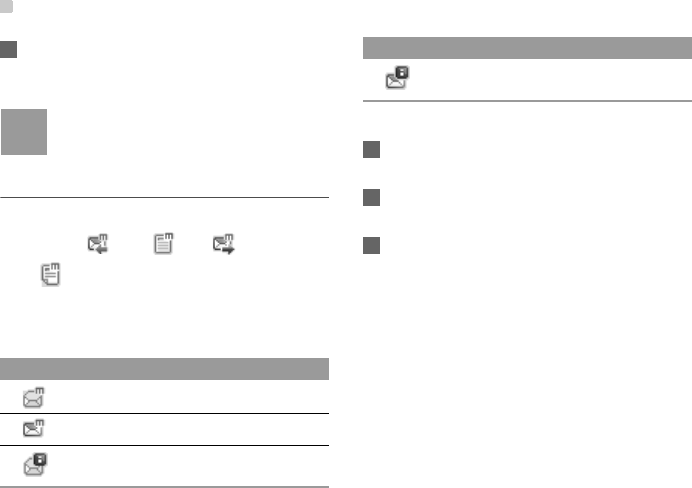
Multimedia Messages
26
5 Return to the Edit MMS screen, and select
Options > send to send the multimedia
message.
Note
If the video file is chosen in the image-edit-
ing field, you cannot edit the music-editing
field any more.
MMS Mailboxes
The Phone provides four mailboxes for MMS,
namely, Inbox ,Drafts , Sent and Tem-
plates .
◆ Inbox
Inbox is used to save received multimedia messages.
Icons in Inbox
Viewing Messages in Inbox
1Select a multimedia message to view its con-
tents.
2During the playing, you can select Stop to stop
playing.
3Select Options for the following operations.
• Reply MMS: to reply a MMS to the MMS
sender.
• Reply SMS: to reply a SMS to the MMS
sender.
• Forward: to forward a MMS.
• Edit before call: to edit the number.
• Next page: to play the next page.
• Previous page: to play the previous page.
• Rewind: to return to the first page.
• Save: to save the selected object.
Icon Description
a read message
an unread message
a read notice or delivery report for an
MMS
an unread notice or delivery report for an
MMS
Icon Description
U121.book Page 26 Friday, October 19, 2007 10:40 AM

Multimedia Messages
27
Messaging
7
• Object list: After entering the content list of this
message, you may select an item and select
Save to save the message to a corresponding
directory of the folder.
• Save number: To save the numbers retrieved
from an MMS to phone or SIM memory or an
existing entry in the contacts.
• Extract URL: To extract URL address from an
MMS for browsing web pages or stream
media.
• Save Email address: To retrieve email address
from MMS and save.
◆ Drafts
Drafts is used to save the multimedia messages you
created and saved and those which failed to be sent.
Icons in Drafts
: A multimedia message saved after you created
it or a multimedia message failed to be sent.
Viewing and Editing Messages in Drafts
1Access Drafts and select a multimedia mes-
sage.
2Press to access the editing screen.
3You can edit the message. The operations are
the same as those for creating a multimedia
message.
◆ Sent
The Sent is used to save the multimedia messages
that have been sent successfully.
Icons in Sent
: A multimedia message has been sent.
Viewing Messages in Sent
1Select a multimedia message to view its con-
tents.
2During playing an MMS, you can select Stop to
stop playing.
3During playing, you may select Options to do
the same operations as those of MMS Inbox.
Refer to "Messaging/MMS/MMS Mailboxes" on
page 26.
U121.book Page 27 Friday, October 19, 2007 10:40 AM

Multimedia Messages
28
◆ Templates
To send messages quickly, you can save commonly
used multimedia messages as templates.
◆ Folder
You can categorize your multimedia messages into
different folders.
You can access Folders from the four tabs of Inbox,
Drafts, Sent or Templates.
Let us take the example of entering the Inbox
screen.
Select MMS > Inbox. Then select Options >
Folders. You can perform the following operations.
• Select: to access a folder.
• Rename: to rename a folder.
MMS Settings
Select Messaging > Settings > MMS, and then you
can set parameters related to multimedia messages.
It contains the following submenus.
◆ Sending
This option is used to set parameters related to send-
ing multimedia messages.
• Valid period: The time for a multimedia message
stored in the message centre after it is sent.
• Delivery report: You have two alternatives, On and
Off. With this mode enabled (On), the network will
report on successfully sending a multimedia mes-
sage.
• Reading report: To set whether to accept a read
report.
• Send limit: To set the size limit of a multimedia mes-
sage to be sent.
• Save on send: To set whether to save a multimedia
message to the sent folder after it has been sent.
• Sender visibility: To set whether the sender infor-
mation will be displayed when a multimedia mes-
sage is sent.
◆ Receiving
This option is used to set parameters related to
retrieval of multimedia messages.
• Send delivery report: You have two options, On and
Off. When this mode is enabled (On), the network
sends a report to the sender indicating that you
have received the message.
U121.book Page 28 Friday, October 19, 2007 10:40 AM
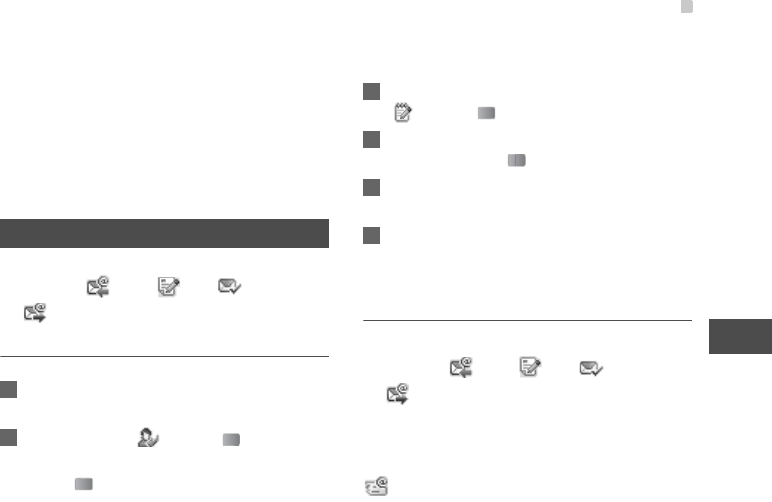
Email
29
Messaging
7
• Send read report: To set whether to send a read
report.
• Receiving limit: To set the size limit of a multimedia
message that you can receive.
• Auto receive: To set whether the phone auto
receives multimedia messages or not.
Settings such as "Network Access Point" and "WAP
gateway" are all preset for your convenience.
Email
The Phone provides four mailboxes for email,
namely, Inbox , Drafts , Sent and Out-
box .
Creating an Email
1Select Messaging > Write Email from the main
menu.
2Select Recipients and press .
• Select one record in the recipients list and then
press to enter an email address.
• Select Options > Contact/Group/History to
select an email address.
3In the email editing screen, select Subject
and press to edit the contents.
4In the email editing screen, select the Content
text box and press to edit the content.
5In the email editing screen, select Attachment
to attach picture, music, video, or eBook.
6In the email editing screen, select Options to
save or send the email. The saved emails are in
Messaging/Email/Drafts.
Mailboxes
Your phone provides four mailboxes for Emails,
namely, Inbox , Drafts , Sent and Out-
box .
◆ Inbox
All Emails received are saved in the inbox.
Icons in Inbox
: A read email.
U121.book Page 29 Friday, October 19, 2007 10:40 AM
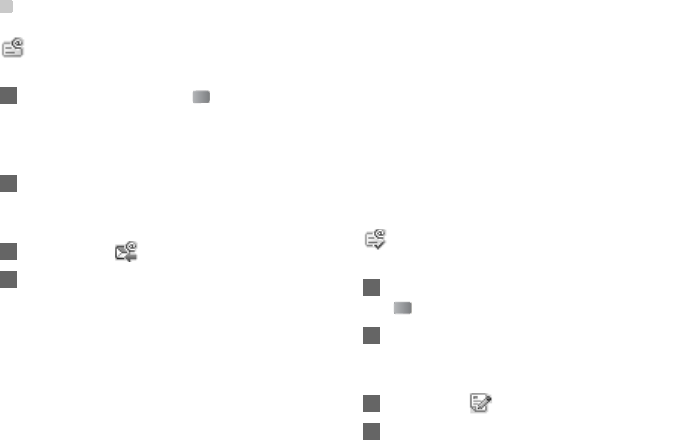
Email
30
: An unread email.
Viewing and Editing Emails in Inbox
1Select an email and press to view the con-
tent. If only the title of this email is received, the
phone prompts whether to download other infor-
mation of the email.
2In the details screen, select Options > Reply to
reply to the sender.
Other Options for Inbox
1Access Inbox of email.
2Select Options for the following operations.
• View: to view the selected email.
• Reply: to reply to the selected email.
• Forward: to forward the selected email.
• Move to folder: to move the selected email to a
specified folder.
• My folders: to categorize your emails in differ-
ent folders.
• Sync inbox: to synchronise emails from server.
• Sort: to sort your emails according to date,
sender or subject.
• Delete: to delete the selected email.
• Mark: to mark an email in the inbox.
• Unmark all: to unmark all emails in the inbox.
• Mark all: to mark all emails in the inbox.
◆ Drafts
The saved new emails are saved in the drafts.
Icons in Drafts
: Emails to be sent.
Viewing and Editing Emails in Drafts
1Select the desired email in the drafts and press
to access the editing screen.
2Edit the related information. For details, perform
the same operations as in creating an email.
Other operations in Drafts
1Enter Drafts of email.
2Select Options for the following operations.
• Edit: to edit the selected email.
• Write Email: to create a new email.
U121.book Page 30 Friday, October 19, 2007 10:40 AM
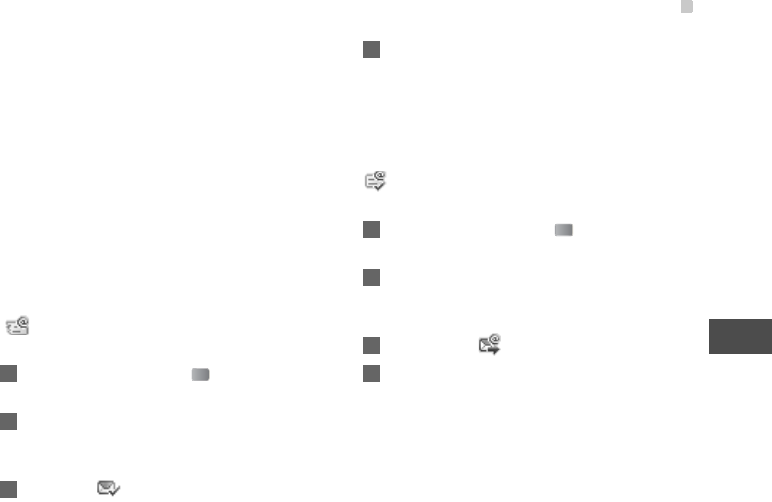
Email
31
Messaging
7
• Move to folder: to move the selected email to a
specified folder.
• My folders: to categorize your emails in differ-
ent folders.
• Sort: to sort your emails according to date,
sender or subject.
• Delete: to delete the selected email.
• Mark: to mark an email in the inbox.
• Mark all: to mark all emails in the drafts.
• Unmark all: to unmark all emails in the drafts.
◆ Sent
The emails sent to server are saved in the sent.
Icon for Sent
: A read email.
Viewing and Editing Emails in Sent
1Select an email and press to access the edit-
ing screen.
2Edit the related information. For details, perform
the same operations as in creating an email.
Other Options in Sent
1Enter Sent of email.
2You may select Options to do the same opera-
tions as those of Inbox.
◆ Outbox
Those emails which failed to be sent are retained in
the outbox.
Icon for Outbox
: Emails failed to send.
Viewing and Editing Emails in Outbox
1Select an email and press to access the edit-
ing screen.
2Edit the related information. For details, perform
the same operations as in creating an email.
Other Operations in Outbox
1Enter Outbox of email.
2Select Options for the following operations:
• Edit: To edit the selected email.
• Send: To send the selected email.
• Move to folder: To move the selected email to
a specified folder.
U121.book Page 31 Friday, October 19, 2007 10:40 AM

Email
32
• My folders: To categorize your emails in differ-
ent folders.
• Sort: To sort your Emails according to date,
sender or topic.
• Delete: To delete the selected email.
• Mark: To mark an email in the inbox.
• Unmark all: To unmark all emails in the outbox.
• Mark all: To mark all emails in the outbox.
◆ My Folders
You can categorize your emails in different folders.
You can enter My Folders from the inbox, drafts, out-
box and the sent box.
Let's take the example of the folder of the inbox.
Select Email > Inbox. Then select Options > My
Folders for the following operations.
• Rename: To rename the folder.
• Select: To enter one folder.
Email Settings
Select Messaging > Settings > Email to set the fol-
lowing items.
◆ Accounts
1Select Options > Add account and enter the
account name. Press to access the General
settings screen.
2The related account information contains:
Account name, From name, From address, Pro-
tocol, Incoming server, User name, Password,
and Outgoing server.
3Select Options > Advanced settings to access
the Advanced Settings screen.
4Return to the Account screen. Select Options >
Activate to activate this account.
5To delete an account, select an account and
then select Options > Delete account.
Note
For the account settings, contact your
service provider.
◆ Common Options
• Reply with history: To reply with history.
U121.book Page 32 Friday, October 19, 2007 10:40 AM

Push Inbox
33
Messaging
7
• Save sent Email: To save sent emails to the sent
box.
• Sending limit: To set the size of an email.
• Receiving limit: To set the limit of the received
email. If the size of the email exceeds the limit, only
the title of the email will be received. If Only header
is selected, only the title of the email will be
received.
• Network Access Point: This option is used to select
information about the profile to be adopted when
you send emails. For more information, contact
your service provider.
After completing all settings, press Back.
◆ Memory Status
The memory in use of Inbox, Drafts, Outbox, Sent,
My folders and Total are displayed.
Push Inbox
The Push Inbox is used to save the Push messages
you have received.
Viewing Push Messages
In the Push Inbox, select a Push message, and then
press to view the details of the Push message.
◆ Icon for Push Inbox
• : A read Push message.
• : An unread Push message.
◆ Other Operations for the Push Inbox
• Load: To start the WAP browser and connect a URL
specified by the Push message.
• Delete: To delete the selected messages.
• Mark: To mark a push message in the inbox.
• Unmark all: To unmark all Push messages.
• mark all: To mark all the Push messages.
Push Inbox Settings
Select Messaging > Settings > Push messages to
set the Push inbox.
◆ Push message setting
You can set the acceptable push messages.
U121.book Page 33 Friday, October 19, 2007 10:40 AM

Broadcast Inbox
34
◆ Enable push SL
You can enable or disable the push SL function by
selecting On or Off.
Broadcast Inbox
The broadcast messages are saved in the broadcast
inbox. You can set the broadcast message.
Select Messaging > Settings > Broadcast to set the
following items.
• Service: to enable or disable this service.
• Subscription: to subscribe to broadcast channels or
cancel the subscription.
• Language: to select the language of the broadcast.
• Silent alert: to specify whether a silent alert occurs
when there is a new broadcast message.
• Auto delete: to set whether to auto delete earlier
messages when the broadcast inbox memory is
full.
Voice Mail number
The voice mail number is already preset for you in the
phone. To access your voicemail, press and
hold in standby mode. The phone dials the voice
mail number automatically.
Common Phrases
Your phone has been preset with some commonly
used phrases. They are used for editing a new mes-
sage, sending a message while answering a call and
auto replying. You can select Messaging > Settings
> Common phrases to edit them if you want.
U121.book Page 34 Friday, October 19, 2007 10:40 AM
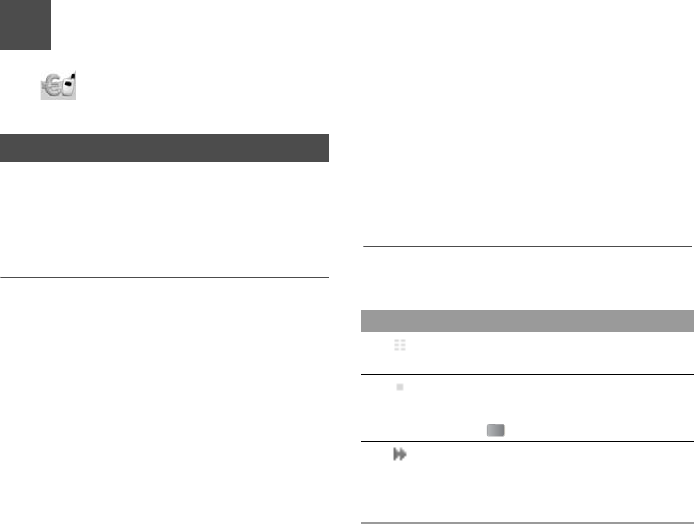
35
8Music
Music enables you to manage your music files
easily and conveniently.
My music
You can play various music files, including those sup-
plied with the phone, recorded by using the phone,
downloaded from the Internet, and attached to email.
You can also enjoy the online audio files.
Function Options During Playing
During playing the music file, select Options for the
following operations.
• Nowplaying: To access the current playlist.
• Play Via Bluetooth: To play audio files through the
Bluetooth device.
• Mute/Unmute: To mute or unmute the music.
• Bookmarks:To access the bookmark list.
• Playlist: To access the music playlist.
• Shuffle: On/Off the random play.
• Loop: To select to cycle play current music, play all
music or close.
• Equilibrium: To select the music style.
• Settings:To set the Full screen direction, and
Streaming setting.
• Video camera:To enable the video camera function.
• History:To display the records of the played music.
• Info.:To view the information of the music files.
• Exit: To exit the music play screen.
Screen Operations During Playing
During playing the music file, you can perform the fol-
lowing operations on the music file.
Operation Description
Press the up scroll key to access the
current playlist.
Press the down scroll key to go back
the beginning of the current music file.
Press to replay this music file.
Press the right scroll key to access the
next music file. Press and hold the right
scroll key to fast forward the current
music file.
U121.book Page 35 Friday, October 19, 2007 10:40 AM
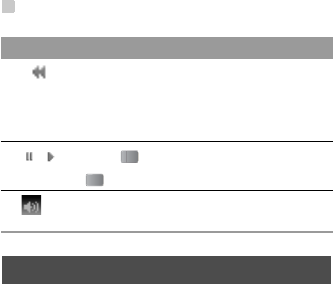
Playlist
36
Playlist
Selecting this option, you can rename and edit the
playlist as well as play the music in the playlist.
Press the left scroll key to access to the
last music file. Press and hold the left
scroll key to fast backward the current
music file.
/Press to pause the playing. Press
again to resume the playing.
Press the volume keys to adjust the vol-
ume.
Operation Description
U121.book Page 36 Friday, October 19, 2007 10:40 AM

37
9Organiser & Tools
This function provides you with various assistant
tools. You can access the Organiser & Tools screen
by selecting from the main menu.
SIM ToolKit
Your Phone supports a number of intelligent SIM
ToolKit (STK) functions such as location based ser-
vices. For more information, contact your service
provider.
Alarms
You can set several alarm clocks. You can also set
the prompt messages, alarm tones and the cycle
period for alarm clocks.
Setting Alarm Clocks
Enter alarm function, you can select one alarm from
the list, and then press to set an alarm clock.
In the screen for editing alarm clock, you can set the
following items: alarm time, the prompt message, the
ringtone, the alarm cycle, the snooze function, the
vibration function, the alarm tone.
Prompt Interface for an Alarm
When it is time for an alarm clock to ring, the selected
alarm tone is played and a prompt interface is dis-
played. You can stop the ringing by pressing any key.
On the prompt interface, you can select to snooze or
stop the alarm prompt.
If your phone is powered off, the alarm clock can still
ring. When the alarm rings, you can choose to power
on the phone.
Stopping the Alarm Clock
Select an alarm clock from the list, and press the left
function key to deactivate it.
Calendar
With this function, you can view the calendar and
manage your schedules.
U121.book Page 37 Friday, October 19, 2007 10:40 AM

Calendar
38
New Schedule
Enter calendar function, you can select Options >
New to create the schedule events for the current
day.
In the screen for editing schedule, you can set the fol-
lowing items: schedule title, schedule location,
schedule type, starting/ending time of the schedule,
whether the alarm is on, when to prompt before the
start time, alarm cycle, schedule content, sound
alarm, Vibration, select tone, and image files.
Note
You can create up to 500 schedules in total
and 15 for each day. While creating a new
schedule, you need to set the alarm on
before setting the alarm time, the alarm
cycle, the alarm tone and the image.
Calendar Functions
Enter calendar function and select Options. You can
perform the following operations.
• New: To create a new schedule.
• Go to: To go to a certain date directly from the
Month view screen.
• Display event: To view all events, specified events,
Calendar files and to back up all schedules to a
memory card.
• View mode: To view the calendar in three different
modes: month view, week view, and day view.
• Management: To manage all schedules, including
Backup all and Restore data.
• Delete event: To delete all events, all past events or
specific period events.
• Settings: To set save location, main view, week
begin day.
• Memory status: To view the memory status, includ-
ing the used space and the total space.
Prompt Interface for a Schedule
When it is time to remind you of a schedule, the
selected ringtone is played and a prompt interface is
displayed. You can stop the ringing by pressing any
key. On the prompt interface, you can snooze the
alarm or stop the prompt.
U121.book Page 38 Friday, October 19, 2007 10:40 AM

Task
39
Organiser & Tools
9
Task
You can define and manage tasks to be conducted
before a certain time. Your phone can remind you of
these tasks and track them automatically.
Select Task from Organiser & Tools.The tasks are
classified into three kinds: pending, done, and all.
You can define up to 1000 tasks on your phone.
New Tasks
To define a new task, press or select Options >
New on the Tasks screen.
In the screen for editing task, you can set the follow-
ing items: the title of the task, the deadline, the prior-
ity level, the task state, the task alert, sound alarm,
vibration, the alert time, the task type.
Tasks Functions
On the Tasks screen, you can also perform the fol-
lowing operations: edit, new, send, copy, day view,
set as done, delete, delete all and memory status.
Prompt Interface for a Task
When it is time for the phone to remind you of a task,
it rings automatically and a prompt interface is dis-
played. You can stop the ringing by pressing any key.
On the prompt interface, you can select to snooze or
stop the task prompt.
Memo
You can store important events on your phone. You
can save up to 100 such memos.
Select Memo from Organiser & Tools. If there is no
memo, you need to create one when you access the
Memo screen.
On the Memo Pad screen, you can perform the fol-
lowing operations: edit, new, send, delete, delete all
and view the memory status.
Synchronise
You can synchronise contacts with your personal
phone book stored on a network server. This service
U121.book Page 39 Friday, October 19, 2007 10:40 AM

Calculator
40
is network dependent. Contact your service provider
for further details.
Select Synchronise from Organiser & Toolsto
create or edit a profile. Select Options > View log to
view the latest synchronisation log. Before you use
the synchronise function, you may need to set a pro-
file.
1To create a profile, select Options > New to cre-
ate a profile.
2Press the left/right scroll key to switch between
Synchronise item, Server Setting, and Network
profile.
3In the Synchronise item screen, select the item
to be synchronized and press to confirm it.
Then, enter the Database name, User name,
Password of the synchronisation items.
4In the Server Setting screen, enter the Server
Address, User name, and Password.
5In the Network profile screen, enter the Proxy
address and the Proxy port. Then, enter the
Network Access Point and select a desired pro-
file.
6Return to the previous menu and select Options
> Synchronise to start synchronising.
Note
This service is not available in all networks.
Please contact your service provider for
more information.
Calculator
You can perform addition, subtraction, multiplication,
division and extraction operations on your phone.
• Press the number keys to enter the figures.
• Press the scroll key to enter the operators.
• Press the left function key to clear.
• Press the right function key to exit Calculator.
• Press to enter a radix point.
• Press to delete the character to the left of the
cursor.
• Press to enter an equal mark.
U121.book Page 40 Friday, October 19, 2007 10:40 AM
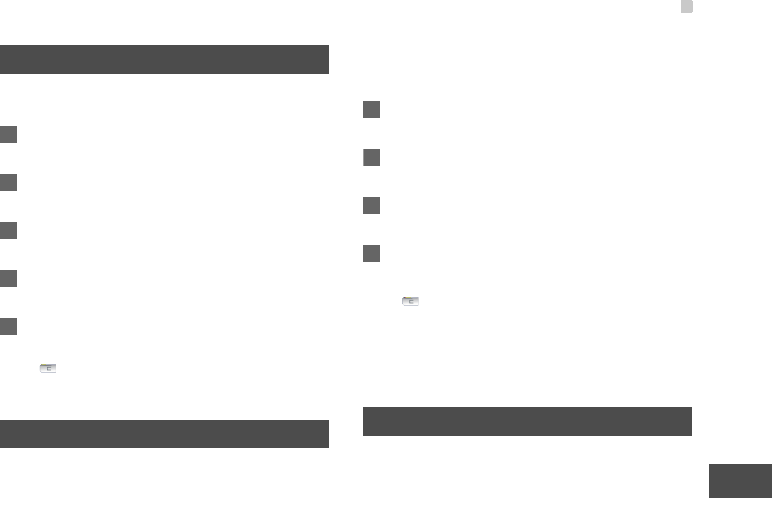
Unit converter
41
Organiser & Tools
9
Unit converter
You can convert units of length and weight between
different systems on your phone.
1Press the up/down scroll key to select the unit
type bar, input unit bar or output unit bar.
2On the unit type selection bar, press the left/right
scroll key to select weight or length.
3On the From bar, press the left/right scroll key to
select the unit to be converted from.
4On the To bar, press the left/right scroll key to
select the unit to be converted to.
5Press the number keys to enter a numeric value
to be converted in the Input bar.
Press or select CE to clear the numeric values
you entered.
Currency converter
You can convert a value from one currency to another
using your phone.
To using this function, access the Currency con-
verter screen, and then press the up/down scroll key
to switch between the setup items.
1On the Input bar, press the number keys to enter
a numeric value to be converted.
2On the From bar, press the left/right scroll key to
select the currency to be converted from.
3On the To bar, press the left/right scroll key to
select the currency to be converted to.
4On the Rate bar, enter the currency rate.
Then you can view the conversion result.
Press to clear the numeric values you entered.
Select Setting in the currency converter screen, and
you can select frequently used currency units. This
makes it easy to switch between selected units in the
From or To bar.
Voice recorder
You can record voices or sounds on your phone.
On the standby screen of the voice recorder, you can
select Options to set the recording duration.
U121.book Page 41 Friday, October 19, 2007 10:40 AM

World Time
42
• Record/Pause: Press to start the recording. Dur-
ing recording, press to pause, and press
again to resume.
• Stop and save: During recording, press the left
function key to stop recording.The audio file is
saved in My Files\Music automatically.
• Play an audio file instantly: After recording is com-
plete, select Option > Play to play the audio file
instantly.
Alternatively, you can select for the following opera-
tions: Send, Play, Set as ringtone and Delete.
World Time
You can view the time of important cities around the
world. To switch among the time zones, press the left/
right scroll key.
If the daylight saving time (DST) is used in your city,
you need to set the phone to DST. Then, you can get
the right local time. To set the phone to DST, switch to
the desired time zone and then select Options > Set
to DST.
Stopwatch
You can use the stopwatch function and save up to
five records on your phone.
On the Stopwatch screen, you can perform the fol-
lowing operations: start, save, pause, continue, reset.
Timer
You can set a timer for up to 99 hours and 59 min-
utes. After you have set it, the timer is displayed on
the home screen.
Service dial number
You can contact your service provider by dialing this
number.
U121.book Page 42 Friday, October 19, 2007 10:40 AM

43
10My Files
My Files enables you to manage the Pictures, Music,
Ringtones, Videos, Games, Applications and other
files conveniently. You can access My Files by
selecting from the main menu.
Select Pictures, Music, Ringtones or Videos
folder. You can perform the following operations on
files.
• View: To view the picture file.
• Play: To play a selected file.
• Send: To send the selected file by MMS, Email or
Bluetooth.
• Set as: To set the picture as the wallpaper or the
image of a contact.
• Set as ringtone: To set a ringtone as voice call tone,
video call tone or specific contact tone.
• Picture edit: To edit a picture file.
• Rename: To rename the selected file.
• Cut: To cut the selected file.
• Copy: To copy the selected file.
• Sort by name/date: To sort the selected file by
name or by date.
• Delete: To delete the selected files.
• Mark/Unmark: To select one or more files or cancel
the selection.
• Info.: To view the properties of one or more files.
Note
Some sound files are protected by Digital
Rights Management (DRM), and may not be
able to be used as a ringtone.
Select Games, applications, other folder.
• Games: To play games and download more games.
The downloaded files are saved in this folder. For
more details, Please refer to "Entertainment/
games" on page 46.
• Applications: Any applications that you download
are saved in this folder.
• Others: you can save any kind of file. You can also
create new folders in this folder to categorise your
files.
When the phone detects and recognises the memory
card, Memory card is displayed as a tab on the top
of the My Files screen. You can perform the same
operations on the contents in the memory card as
those in the phone. Your phone also provides a func-
tion to format the memory card.
U121.book Page 43 Friday, October 19, 2007 10:40 AM

44
11Browser
The built-in browser makes it easy and pleasant to
tour around the Internet. You can access the Browser
screen by selecting Browser from the main menu.
Browser
Browsing Pre-set Web Pages
On the homepage, select a link from the page. Then
select to browse the page. When browsing, you
can press the scroll keys to select a link you want to
access. The selected link is highlighted. Press to
access the link.
Other Operations for the Homepage
After selecting Options from the homepage, you can
perform the following operations:
• Homepage: To access the homepage.
• Forward: To go forward when you browse web
pages.
• Bookmarks: To access the bookmark directory and
view the saved bookmarks.
• Enter URL: To enter a website address and access
it.
• Recent pages: To access pages you have browsed
recently. The recently browsed pages can be
saved.
• Save page: To save the pages in your phone. Web
pages are saved to the Saved pages.
• Save item: To save contents on the page to the
folders in your phone.
• Refresh: To refresh the current web page.
• Saved pages: To browse the saved pages offline.
• Settings: To change the relevant settings for the
web page.
• Exit: To exit the current web page.
Enter URL
Access the Enter URL screen, and then you can
enter the address of the page to be accessed. You
can select Goto, Edit, Delete or Delete all from the
Options to perform corresponding operations upon
the entered website address.
U121.book Page 44 Friday, October 19, 2007 10:40 AM

Bookmarks
45
Browser
11
Bookmarks
With this option, you can save and edit the informa-
tion of the websites that you often access.
Select any one of them, and then select Options,
you can perform the following operations.
• Goto: To connect to the server to get the latest web
page.
• Add: To add a Title and Address for a bookmark.
• Edit: To edit the selected bookmark. The preset
bookmarks cannot be edited.
• Delete: to delete the selected bookmark.
Internet Settings
These are preset for you to use the Internet service. If
you need to modify them, open the Browser and
select Internet Settings.
U121.book Page 45 Friday, October 19, 2007 10:40 AM
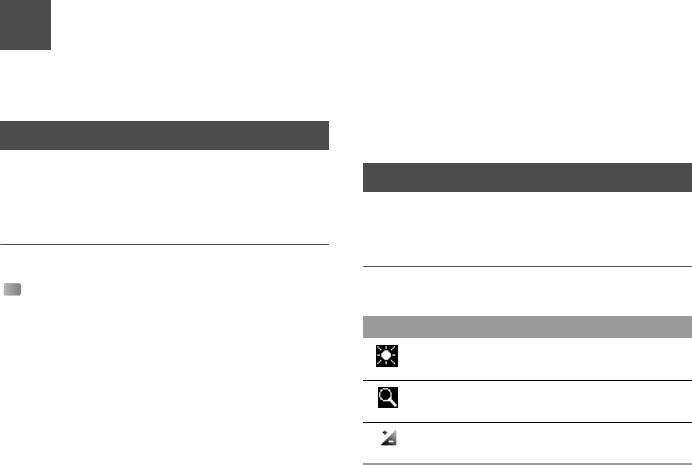
46
12Entertainment
You can use the phone to play games, take photos,
listen to online music, and listen to FM radio.
Games
You can play games and download more games.
Downloaded games are saved to the My Files/
Games directory.
Available Options of Games
You can scroll the cursor to a Java game and press
or select Options > Select to launch the game.
In the Games screen, you can select Options to per-
form the following operations:
• Select: To launch the game.
• Update: To upgrade the game.
• Move: To move games saved in the phone to the
memory card and vice versa.
• Security: To set the security requirements of the
game.
• Send: To send the game to a recipient by email or
Bluetooth.
• Settings: To set the volume, vibration and internet
settings.
• Delete: To delete the game.
• Info.: To view the property of the game.
Camera
Press the Camera key or select Entertainment >
Camera to launch the camera.
Operations in the Viewfinder Screen
In the viewfinder screen, you can:
Icon Operation
Press the left/right scroll key to adjust
the brightness.
Press the up/down scroll key to zoom in
or zoom out.
Press the up/down volume key to adjust
the contrast
U121.book Page 46 Friday, October 19, 2007 10:40 AM

Video Camera
47
Entertainment
12
Note
If you use the assistant lens and set the res-
olution to 1280 ×1024 or 1280 ×960, you
cannot zoom in or zoom out.
In the viewfinder screen, you can select Options to
choose from the following operations:
• Video camera: To record a video clip.
• Frame: To choose a frame for pictures.
• Normal size/Screen size: To set the viewfinder size.
• Go to gallery: To access the My Files/Pictures
directory to view pictures.
• White balance: The phone provides you with
several modes, including auto, fluorescent,
incandescent, outdoor, indoor, night mode.
• Internal/External view: To switch between the assis-
tant lens and the main lens.
• Capture Mode: To set the shooting mode.
• Self timer: To set the countdown time for the phone
to take a picture automatically.
• Settings: To change the relevant settings for
camera function.
Operations After Taking a Picture
In the viewfinder screen, you can press to take a
picture. Pictures taken are auto saved to the
My Files/Pictures directory.
After taking a picture, you can select Options for the
following operations.
• Send: To send the picture through MMS, Bluetooth
or email.
• Set as: To set the picture as the wallpaper or the
image of a contact.
• Edit: To edit the picture.
• Delete: To detelet the picture.
Video Camera
You can use your phone to record a video.
In the main menu, select Entertainment > Camera.
In the camera viewfinder screen, select Options >
Video camera to launch the video camera.
Operations in the Viewfinder Screen
In the viewfinder screen, you can:
U121.book Page 47 Friday, October 19, 2007 10:40 AM
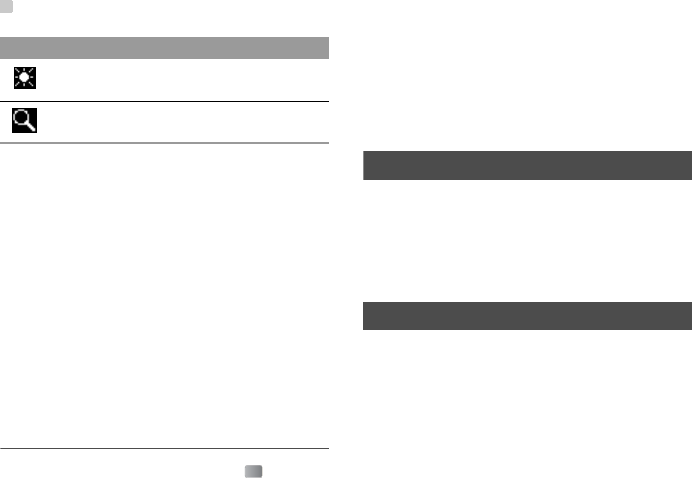
Music
48
In the viewfinder screen, you can select Options to
choose from the following operations.
• Camera: To launch the camera.
• Record: To start recording the video.
• Zoom display: To zoom in or zoom out.
• Internal/External view: To switch between the assis-
tant lens and the main lens.
• Go to gallery: To access the My Files/Videos direc-
tory to view videos.
• Settings: To change the relevant settings for video
camera function.
• Available memory: To view the total duration of all
videos, and the free space.
Operations During Recording
In the viewfinder screen, you can press to start
recording the video.
During the recording, you can perform the following
operations.
• Pause/Record: To pause and then to start recording
again.
• Stop: To stop recording.
Music
Music enables you to manage your music files easily
and conveniently. It can play all kinds of music files. it
also enables you to purchase music, manage the
channels and play streaming media. For more
details, Please refer to "Music" on page 35.
FM Radio
FM Radio helps you conveniently listen to the FM
radio programs. Select Entertainment > FM Radio,
and then press the up/down scroll key to switch the
channel.
You can select Options for the following operations.
• Loudspeaker/Headset: To switch between the
Handsfree and the Earpiece modes.
Icon Operation
Press the left/right scroll key to adjust
the brightness.
Press the up/down scroll key to zoom in
or zoom out.
U121.book Page 48 Friday, October 19, 2007 10:40 AM

FM Radio
49
Entertainment
12
• Tuning: The phone provides you with several
modes, including Automatic Tuning, Manual
Tuning, Inching Tuning, and Set Frequency.
• Add to Channel List: Add the current FM radio
channel to the channel list
• Channel List: To access Channel List screen.
• Exit: To exit the FM Radio funtion.
U121.book Page 49 Friday, October 19, 2007 10:40 AM

50
13Connections
Your phone provides you with many data communi-
cation functions. You can access the Connectivity
screen by selecting Settings from the main
menu. You can synchronise data between your
phone and a PC through USB cable or Bluetooth.
You can transfer files from your phone to other Blue-
tooth devices and conversely. You can also use the
built-in modem of your phone to set up a dialup con-
nection for your PC to access the Internet.
Bluetooth
You may use the built-in Bluetooth function of your
phone to synchronise data between a PC and your
phone, or use the built-in modem of your phone to
access the Internet with a PC, or exchange data with
other Bluetooth devices. You can also talk by using
the Bluetooth headset or Bluetooth loudspeaker.
Note
The Bluetooth function supported by your
phone meets the requirements of Bluetooth
Specification 1.2. It can work successfully
only if you use it with compatible Bluetooth
devices. For more information, refer to the
user manuals of related devices, or consult
the manufacturer of related devices.
Bluetooth-Based Synchronisation
Your phone can respond to data synchronisation
requests from a computer.
To operate the Bluetooth synchronisation with your
phone, your PC needs to support Bluetooth function.
If not, see page 53 on how to use a USB connection.
1Install the Mobile Phone PC Assistant supplied
with your phone. After inserting the CD, follow
the prompts to complete the installation.
2Select Settings > Connectivity > Bluetooth >
Switch On/Off > On to enable the Bluetooth
function.
3Run the driver software for Bluetooth on the PC,
and pair the phone. After the PC detects and
recognises the phone serial port service, acti-
vate the Bluetooth serial port service on the
phone.
U121.book Page 50 Friday, October 19, 2007 10:40 AM

Bluetooth
51
Connections
13
4Run the Mobile Phone PC Assistant on the PC.
5You can now operate the synchronisation. For
details of the operation, refer to the Help of the
Mobile Phone PC Assistant.
The Bluetooth Headset
You can answer a call by a Bluetooth headset or
Bluetooth loudspeaker. For details, refer to the corre-
sponding user manual of a Bluetooth headset or
loudspeaker.
Select Settings > Connectivity > Bluetooth to
access the Bluetooth Settings screen.
To use a Bluetooth headset, do as follows.
1Set the Bluetooth headset to the status for
detecting.
2Select Switch On/Off > On from the Bluetooth
settings list to enable the device. A Bluetooth
device icon appears on the icon bar.
3Select Devices and then select Search. When
the Bluetooth headset is found, its profile is dis-
played in the device list.
4If a Bluetooth headset is detected and recogn-
ised for the first time, it should be authenticated
by a PIN code.
Now you can use the Bluetooth headset as the con-
nection has been established between your phone
and the Bluetooth headset.
The Bluetooth headset should be set to the status for
detecting only when authentication is needed. Once
the headset has been authenticated, you just need to
turn on your Bluetooth headset. For more informa-
tion, refer to the user manual of your Bluetooth head-
set.
Note
The procedure for using a Bluetooth loud-
speaker is similar to that for a Bluetooth
headset. For details, refer to the user man-
ual supplied with your Bluetooth loud-
speaker.
Bluetooth-Based Data Transfer
You can exchange data between your Bluetooth
phone and other Bluetooth devices. If you want to
exchange data between your phone and another
U121.book Page 51 Friday, October 19, 2007 10:40 AM

Bluetooth
52
device, that device must support Bluetooth and the
Bluetooth function must be enabled.
1Select Switch On/Off > On from the Bluetooth
settings list to enable the Bluetooth device. A
Bluetooth device icon appears on the icon bar.
2Select Devices list.
3Select Options > Search to search a Bluetooth
device. When a Bluetooth device is found for the
first time, authentication is required.
Now you can exchange data between your phone
and the other Bluetooth device.
In transferring data by Bluetooth, the received con-
tacts, Memo Pad records, schedule events and To Do
tasks will be saved to Contacts, Memo Pad and To
Do, and other media and data files will be saved to
the corresponding folders in My Files.
Bluetooth-Based Internet Access
Connecting your phone to a PC through Bluetooth
function enables the PC to use the phone as a
modem. This helps to set up a dial-up connection to
the Internet. (This is particularly useful for laptop.)
You can create Bluetooth-based Internet access
through the Mobile Phone PC Assistant supplied with
your phone, or the built-in Internet wizard of the Win-
dows operating system, or the Internet wizard sup-
plied with the Bluetooth drive suite of the PC.
Note
Windows 2000 and Windows XP are sup-
ported.
◆ Accessing the Internet using the Mobile Phone
PC Assistant
To access the Internet by Bluetooth using the Mobile
Phone PC Assistant, make sure that your PC sup-
ports the Bluetooth function and your SIM card sup-
ports the Internet access service.
1Select Settings > Connectivity > Modem and
set the port to Modem via Bluetooth.
2Select Settings > Connectivity > Bluetooth >
Switch On/Off > On.
3Make sure that Bluetooth modem is in Device
Manager/Modem of your PC. Run the driver
program for Bluetooth on your PC, and then pair
U121.book Page 52 Friday, October 19, 2007 10:40 AM

USB
53
Connections
13
the U1215 phone. After the PC has detected the
U1215 dial-up network service, you can activate
this service.
4Install the Mobile Phone PC Assistant. After
inserting the CD, follow the prompts to complete
the installation.
5Run the U1215 Dialup Internet to access the
Internet.
◆ Other Bluetooth Operations
You can perform the basic settings for the Bluetooth
functions.
Select Settings > Connectivity > Bluetooth for the
following operations.
• Switch On/Off: To set the Bluetooth device to On or
Off.
• Search new devices: To search for new Bluetooth
devices.
• Devices: To view all detected Bluetooth devices.
• Visibility: To set whether your phone can be found
by other devices when the Bluetooth function is
enabled.
• Rename: To rename your phone.
• My device information: To view the detailed infor-
mation of your phone, such as the device name and
device address.
• Uninterrupted Access On/Off: When this option is
set to On, only the Bluetooth connection
requirement from the trusted device is accepted.
When it is set to Off, the Bluetooth connection
requirements from all devices are accepted.
USB
You can synchronise data between your phone and
PC, surf the Internet with your phone and read the
memory card by USB cable.
!
警告
!
Warning
• To use USB cable, please strictly obey the
following rules. Otherwise, your phone or
PC may be damaged. To connect your
phone with a PC through USB cable, first
connect the USB connector to your
phone, and then connect the other end of
the cable to the PC.To disconnect your
phone from the PC, first disable the
U121.book Page 53 Friday, October 19, 2007 10:40 AM

USB
54
Mobile Phone PC Assistant, then discon-
nect the USB connector from the PC, and
finally disconnect the USB cable from your
phone.
• If the PC cannot recognise your phone
when connecting through the USB cable,
power off and restart the PC and then
retry.
• Do not plug the USB cable in and out of
your phone frequently.
USB-Based Synchronisation
Your phone supports the synchronisation requests
from a PC to your phone.
With a USB cable and Mobile Phone PC Assistant,
your phone can communicate with a PC. You can
back up the contact entries and messages saved on
your phone and the SIM card to a PC. You can also
synchronise contacts, schedule events and To Do
tasks between your phone and Outlook.
To operate the USB-based synchronisation with your
phone, do as follows.
1Install the Mobile Phone PC Assistant. After
inserting the CD, follow the prompts to complete
the installation.
2Select Settings > Connectivity > Modem from
the main menu of your phone and set the port to
Modem via USB.
3Connect your phone to the PC by using the USB
cable.
4Run the Mobile Phone PC Assistant on the PC.
5Now you can operate the USB-based synchroni-
sation. For details of the operation, refer to the
Help of the Mobile Phone PC Assistant.
Accessing the Internet by USB
Connecting your phone to the PC with the USB cable
enables the PC to use the phone as a modem. This
helps to set up a dial-up connection to the Internet.
There are two methods to access the internet by
using the USB cable: use the Mobile Phone PC
Assistant supplied with your phone or to use the Win-
dows operating system to set the service.
U121.book Page 54 Friday, October 19, 2007 10:40 AM

USB
55
Connections
13
1Select Settings > Connectivity > Modem and
set the port to Modem via USB.
2Install Mobile Phone PC Assistant. After insert-
ing the CD, follow the prompts to complete the
installation.
3Connect your phone to the PC by using the USB
cable.
4Ensure the USB device is shown in Device Man-
ager/Port of your PC.
5Select one of the following methods to set up the
dial-up connection.
• Run the U1215 Dial-up Internet on the PC to
create the dial-up connection.
• Create Internet access through the built-in
Internet wizard of the Windows operating sys-
tem.
Note
Only Windows 2000 and Windows XP are
supported.
micro-SD Card Reader
You can read the files saved in the micro-SD card by
using a USB cable.
To use the micro-SD card reader, do as follows.
1Insert the micro-SD card to your phone.
2Connect your phone to the PC by using the USB
cable.
3Found New Hardware is displayed on your PC,
and an icon for the mobile memory drive
appears.
Note
The function of micro-SD card reader and
the other functions using the USB cable are
incompatible. If you enable the micro-SD
card reader, other functions using the USB
cable are unavailable. If you need to
recover other USB functions, disable the
card reader function.
U121.book Page 55 Friday, October 19, 2007 10:40 AM
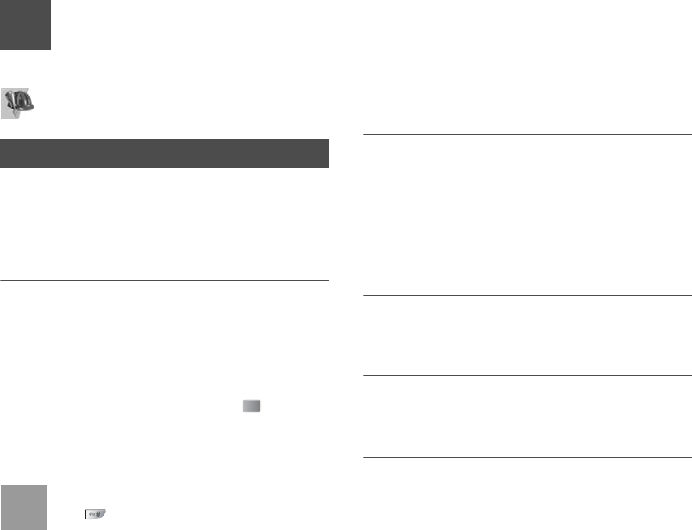
56
14Settings
You can access the Settings screen by selecting
from the main menu.
Phone settings
You can change the settings of the phone, including
Profiles, Phone language, Input language, Date and
time, Date format, Shortcuts, as well as Auto ON and
OFF, Auto keypad lock, Keypad lock period.
Profiles
You can select different profiles for the phone to suit
different environmental situations.
The phone provides various profiles, including Nor-
mal, Meeting, Silent, Activity, Car, Headset,
Offline and My profile.
You can select a profile and then press or select
Options > On to activate this profile. You can also
select Options > Edit to edit the settings for this pro-
file.
Note
In the standby mode, you can press and
hold to switch the current profile to the
meeting profile. If the current profile is
offline, you cannot use this function.
Phone language
Your phone supports several languages. Select Set-
tings > Phone settings > Phone language to select
a language. In addition to these languages, you can
also select Auto. This option is used to set the phone
language to be the same as that used in your SIM
card.
Input language
The option is used to set the language used to enter
text.
Date and time
This option is used to change the system time for the
phone.
Date format
This option is used to change the display format of
the date of the phone. Three formats are available:
yy.mm.dd, mm.dd.yy, and dd.mm.yy.
U121.book Page 56 Friday, October 19, 2007 10:40 AM

Display settings
57
Settings
14
Shortcuts
This option is used to assign the frequently used
functions to the scroll keys as shortcut keys.
Auto ON and OFF
This option is used to set your phone to power on or
off automatically.
1In the Auto ON and Auto OFF screen, enable
this function and set the cycle for Auto On and
Auto Off respectively. Then select Options >
Settings.
2Set the time for Auto On and Auto Off, and then
select Options > Save to save your settings.
Auto keypad lock
The auto keypad lock function can prevent the phone
from reacting to the accidentally key-pressing. You
can enable or disable the function.
Keypad lock period
After enabling the auto keypad lock function, you can
set the keypad lock period. If there is no operation on
the phone within a preset period of time, the keypad
is locked automatically. You can press and to
unlock the keypad.
Display settings
You can change the settings for the phone display,
including Wallpaper, Brightness, Keypad backlight,
Backlight time, LCD sleep delay, Greeting message.
• Wallpaper: To set the wallpaper layout for the home
screen.
• Brightness: To set the brightness of the screen.
• Keypad backlight: To turn the keypad backlight on
or off.
• Backlight time: To set the backlight delay time for
the screen.
• LCD sleep delay: To set the duration between back-
light off and LCD off.
U121.book Page 57 Friday, October 19, 2007 10:40 AM

Message settings
58
• Greeting message: To enter a greeting message
that appears on the screen when you power on
your phone.
Message settings
You can change the message settings including
SMS, MMS, Email, Push messages, Broadcast,
Voice Mail Number and Common phrases.
Call settings
You can change the settings for making calls.
Call forwarding
This option is used to forward incoming calls.
1In the main screen, select Settings > Call set-
tings > Call forwarding.
2Select the forwarding condition from All calls, If
out of reach, If busy, and If not answer.
3Then select the forwarding type from Voice call,
Fax call, Data call and All services.
4Select Activate or Deactivate to enable or dis-
able the service. You can also select Check sta-
tus to check the status of call forwarding service.
Alternatively, you can select Disable all and then
select one from the four items: Voice call, Fax call,
Data call and All services. Then press to disable
all call forwarding services of this type.
Call barring
This option is used to set the call barring mode for the
phone.
Select Call settings > Call barring for the following
options:
◆ Barring outgoing calls:
1Select the barring condition from All outgoing
calls, International calls, and International
calls except home.
2Then select the barring type from Voice call,
Fax call, Data call.
U121.book Page 58 Friday, October 19, 2007 10:40 AM

Call settings
59
Settings
14
3Select Activate or Deactivate to enable or dis-
able the service. You can also select Check sta-
tus to check the status of call barring service.
◆ Barring incoming calls:
1Select the barring condition from All incoming
calls and Incoming calls when abroad.
2Then, select the barring type from Voice call,
Fax call, Data call, and All services. You have
the following options.
3Select Activate or Deactivate to enable or dis-
able the service. You can also select Check sta-
tus to check the status of call barring service.
◆ Disable All
Select one type from Voice call, Fax call, Data call
and All services, and then enter the call barring
password. Press to cancel all call barring services
of each type.
Call waiting
This option is used to enable or disable the call wait-
ing function. You can also view whether the call wait-
ing function is enabled by checking the status.
The call waiting function is network-dependent. For
more information, contact your service provider.
Auto redial
This function is used to auto redial the dialed number
if the dialing failed.
Answer mode
It is used to set the mode for answering an incoming
call. Two options are available: Any key and Send
key.
Auto answer
This option is used to select auto answering for
incoming calls. Select Call settings > Auto answer
for the following options.
• Immediate answer: To answer an incoming call
immediately.
U121.book Page 59 Friday, October 19, 2007 10:40 AM

Call settings
60
• Message: To auto send a text message that is pre-
set and chosen from the Common phrases to the
current caller.
• Recorded message: To answer an incoming call by
auto playing a recorded message.
• Disable: To disable the auto answer function.
Calling ID
This options allows you to select whether to display
your phone number on the phone of the party who
called you.
Select Call settings > Calling ID for the following
options.
• Auto: Whether your phone number will be shown
on the called phone depends on the network.
• Send: Your phone number will be shown (if the net-
work supports this service).
• Hide: Your phone number will not be shown (if the
network supports this service).
Select line
This option is used to set the call line for your phone.
Two options are available: Line 1 and Line 2.
My number
This function can be used to save your own phone
numbers on the SIM card. You can select Options to
edit or delete the records.
Call barring password
This function is used to change the password for call
barring.
Select Call barring password from the Call settings
screen. Then you can change the call barring pass-
word.
Note
The old call barring password is provided by
your network operator if it is the first time for
you to change the password.
Prompt to save
This function is used to prompt whether to save the
number when there is an incoming call. You can
enable or disable this function.
U121.book Page 60 Friday, October 19, 2007 10:40 AM

Video call
61
Settings
14
Video call
You can change the settings for the Video Call func-
tion, including Picture in Picture, Switch picture,
Image quality, Camera off, Audio off, Auto voice call,
Send specific file and Auto answer.
• Picture in picture: To display your image on your
phone and arrange the positions of your image.
• Switch picture: To switch between image windows
during a video call.
• Image quality: To set the image quality for video.
• Camera off: To open or close the video channel
during a video call.
• Audio off: To open or close the audio channel dur-
ing a video call.
• Auto voice call: To enable the auto voice call
function. The phone auto makes a voice call, when
the other party's phone does not support the video
call service.
• Send specific file: To select a file and send it to the
other party when you hold a video call.
• Auto answer: To auto answer an incoming video
call. You can enable or disable this function.
Connectivity
The data connection function provides several data
communication functions. You can synchronise data
between your phone and a PC through a USB cable
or Bluetooth. Your PC can use the built-in modem of
your phone to access the Internet. For detailed infor-
mation, refer to "Connections" on page 50.
Network
You can change the settings for the network.
Select Settings > Network for the following options:
Mode, Select network, Cell information, and My pub-
lic land mobile network (PLMN) list.
Security
You can change the settings related to the phone
security.
Select Security from Settings, and then enter the
correct phone password if you have set the phone
lock to On (the initial password is 0000). Then press
to display the following security setting items.
U121.book Page 61 Friday, October 19, 2007 10:40 AM
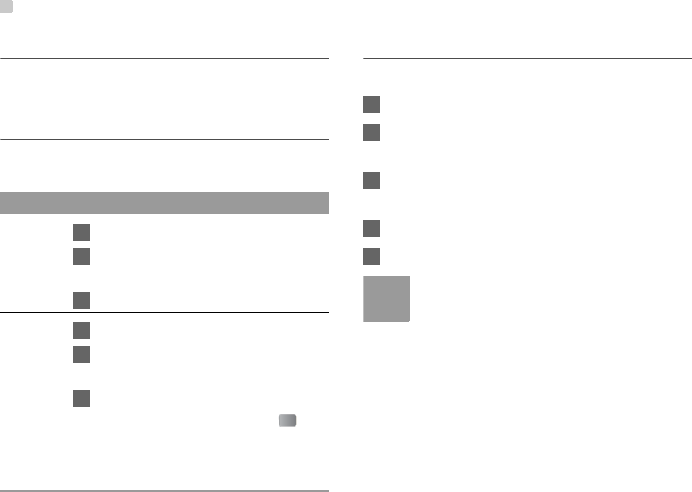
Security
62
Reset
This option is used to reset your phone to the factory
settings.
Password lock
This option is used to enable or disable the "Phone
lock" and "PIN lock".
Change password
You can modify the phone password and PIN code.
1Select Security > Change password.
2Select one item from phone password, PIN
code, and PIN2 code.
3Enter the old password (The initial phone pass-
word of the U1215 is 0000).
4Enter a new password.
5Enter the new password again to confirm.
Note
• To modify the PIN code, you must set the
"PIN lock" to "On" first.
• If you enter the wrong PIN or PIN2 three
times, the SIM card is locked. You need
the PUK or PUK2 code to unlock the SIM
card. If you enter the wrong PUK or PUK2
code 10 times in total, the SIM card is
locked permanently.
• PUK or PUK2 code are delivered with the
SIM card. If you have not received one or
Operation Description
Phone
lock
1Select Phone lock.
2Press the up/down scroll key to
select On or Off.
3Enter the phone password.
PIN lock
1Select PIN lock.
2Press the up/down scroll key to
select On or Off.
3If the desired status is the same as
the current status, just press .
Conversely, you need to select the
desired status and then enter the
PIN code.
U121.book Page 62 Friday, October 19, 2007 10:40 AM

Security
63
Settings
14
have forgotten it, contact your service
provider.
Fixed dialer number
If your SIM card supports the Fixed Dialer Number
(FDN) function, you can set the limit for phone num-
bers.
Select Security > Fixed dialer number for the fol-
lowing options.
• On: You can dial the numbers only in the FDN list.
To enable this function, you need to enter the cor-
rect PIN2 code.
• Off: You can dial any number.
• FDN list: It is used to view the fixed dialer numbers.
To create, edit or delete it, you need to enter the
correct PIN2 code.
DRM Setting
Digital Rights Management (DRM) can protect the
digital content from piracy and protect the provider’s
interests. The digital content includes Java applica-
tions and multimedia content such as images, audio
and video. If the protected content cannot be
accessed, it indicates that the corresponding copy-
right is overdue or used up.
Select Settings > Security > DRM setting. Enter the
correct phone password and press to confirm, and
you can delete all the rights.
U121.book Page 63 Friday, October 19, 2007 10:40 AM

64
15Warnings and Precautions
Electronic Device
• Turn off your phone near high-precision electronic
devices. The phone may affect the performance of
these devices.
• Such devices include hearing aids, pacemakers,
fire alarm systems, automatic gates, and other
automatic-control devices. If you are using an elec-
tronic medical device, consult the device manufac-
turer to confirm whether the radio wave affects the
operation of this device.
• Pacemaker manufacturers recommend that a mini-
mum separation of 15cm be maintained between a
mobile phone and a pace-maker to avoid potential
interference with the pace-maker. To achieve this
use the phone on the opposite ear to your pace-
maker and do not carry it in a breast pocket.
Hospital
Pay attention to the following points in hospitals or
health care facilities:
• Do not take your phone into the operating room
(OR), intensive care unit (ICU), or coronary care
unit (CCU).
• Do not use your phone at places for medical treat-
ment where phone use is prohibited.
• When using your phone near someone who is suf-
fering from a heart disease, turn down the ring tone
volume or vibration properly so that it does not
affect the person.
Area with Inflammables and
Explosives
In any area with inflammables and explosives, turn
off your phone and do not take out, install or charge
the battery, to avoid explosion and fire. Areas with
inflammables and explosives include, but are not lim-
ited to:
• Gas station
• Area for storing fuels (such as the bunk under the
deck of a ship)
• Device/Vehicle for transporting and storing fuels or
chemical products
U121.book Page 64 Friday, October 19, 2007 10:40 AM

Storage Environment
65
15
Warnings and Precautions
• Area with chemical substances and particles (such
as: granule, dust, metal powder) in the air
• Area with the sign of "Explosives"
• Area with the sign of "Turn off bi-direction wireless
equipment"
• Area where it is generally suggested to stop the
engine or a vehicle
Storage Environment
• Do not place magnetic storage media such as mag-
netic cards and floppy disks near the phone. Radia-
tion from the phone may erase the information
stored on them.
• Do not put your phone, battery, or other accesso-
ries in containers with strong magnetic field, such
as an induction cooker and a microwave oven. Oth-
erwise, circuit failure, fire, or explosion may occur.
• Do not leave your phone, battery, or charger in a
very hot or cold place. Otherwise, malfunction of
the products, fire, or explosion may occur.
• Do not place sharp metal objects such as pins near
the earpiece. The earpiece may attract these
objects and hurt you when you are using the phone.
• Do not subject your phone, battery, and charger to
serious collision or shock. Otherwise, battery leak-
age, phone malfunction, overheat, fire, or explosion
may occur.
• Do not put your phone in the back pocket of your
trousers or skirt, to avoid phone damage while
seated.
Children Safety
• Put your phone, battery, and charger in places
beyond the reach of children. Do not allow children
to use the phone, battery, or charger without guid-
ance.
• Do not allow children to put the battery in mouth, for
electrolyte in the battery is poisonous.
• Do not allow children to touch the small fittings.
Otherwise, suffocation or gullet jam can be caused
if children swallow the small fittings.
U121.book Page 65 Friday, October 19, 2007 10:40 AM

Operating Environment
66
Operating Environment
• he phone, battery, and charger are not water-resis-
tant. Keep them dry. Protect the phone, battery and
charge from water or vapor. Do not touch the phone
with a wet hand. Otherwise, short-circuit and mal-
function of the product or electric shock may occur.
• Do not use the phone in dusty, damp and dirty
places or places with magnetic field. Otherwise,
malfunction of the circuit may occur.
• Do not turn on or off the phone when it is near your
ears to avoid negative impact on your health.
• When carrying or using the phone, keep the
antenna at least one inch (2.5 centimeters) away
from your body, to avoid negative impact on your
health caused by radio frequency leakage.
• If you feel uncomfortable (such as falling sick or
qualm) after playing games on your phone for a
long time, please go to see a doctor immediately.
• On a thunder stormy day, do not use your phone
outdoors or when it is being charged.
• Do not touch the antenna when a call is going on.
Touching the antenna may affect call quality and
cause the phone to operate with more power. As a
result, the talk time and standby time are short-
ened.
• The phone may interfere with nearby TV sets,
radios and PCs.
• In accordance with international standards for radio
frequency and radiation, use phone accessories
approved by the manufacturer only.
Cleaning and Maintenance
• Before you clean or maintain the phone, turn off the
phone and disconnect it from the charger. Other-
wise, electric shock or short-circuit of the battery or
charger may occur.
• Do not use any chemical detergent, powder, or
other chemical agent (such as alcohol and ben-
zene) to clean the phone and the charge. Other-
wise, part damage or a fire can be caused. You can
clean the phone and the charger with a piece of soft
antistatic cloth that is a little wet.
U121.book Page 66 Friday, October 19, 2007 10:40 AM

Environmental Protection
67
15
Warnings and Precautions
• Keep the plug dry when you clean it, to prevent fire.
• If the phone or any of its fittings does not work, turn
to the local authorized service center for help.
Environmental Protection
• Please observe the local regulations regarding the
disposal of your packaging materials, exhausted
battery and old phone and please promote their
recycling. Do not dispose of exhausted battery or
old phone in municipal waste.
• This HUAWEI device complies with Directive 2002/
95/EC on the restriction of the use of certain haz-
ardous substances in electrical and electronic
equipment.
: This symbol indicates that the equipment car-
rying this mark must NOT be thrown into general
waste but should be collected separately and prop-
erly recycled under local regulations.
Emergency Calls
You can use your phone for emergency calls. How-
ever, connections in all conditions cannot be guaran-
teed. You should never rely solely on the phone for
essential communications.
Battery
• Use the battery approved by the manufacturer only.
Otherwise, explosion may occur.
• Do not dispose of the battery in fire. Otherwise, the
battery may ignite or explode.
• Do not connect two poles of the battery with con-
ductors such as cables, jewelries or any other
metal material. Otherwise, the battery is short-cir-
cuited and it may burn your body.
• Do not disassemble the battery or solder the bat-
tery poles. Otherwise fluid leakage, overheat, fire,
or explosion may occur.
• If there is battery leakage, smoke, or strange smell,
stop using the battery and keep it away from open
U121.book Page 67 Friday, October 19, 2007 10:40 AM

Charger
68
flame to avoid fire or explosion. Then turn to an
authorized maintenance engineer for help.
• The battery is not fully charged when delivered.
Plug the charger cable into the bottom of the
phone, plug the power supply unit into a mains
power socket and charge for at least two hours.
• If the battery fluid contacts your skin or cloth, wash
with clean water immediately to avoid irritation to
the skin.
• If the battery fluid gets into eyes, do not rub your
eyes. Otherwise, your eyes can be hurt. Wash with
clean water and go to see a doctor immediately.
• If there is battery deformation, color change or
abnormal heating while you charge or store the bat-
tery, take it out immediately and stop using it. Oth-
erwise, battery leakage, overheat, explosion, or fire
may occur.
• When installing the battery, do not push the battery
by force lest battery fluid leak out or the battery
crack.
• Do not take out the battery when the phone is
turned on.
• If you do not use the battery for a long time, store it
in normal temperature after charging.
Charger
• Use the charger approved by the phone manufac-
turer only. Any violation of this rule may result in fire
or malfunction of the charger.
• Do not short-circuit the charger. Short-circuiting the
charger may cause fire or malfunction of the
charger.
• If the power cord is damaged (for example, the lead
is exposed or broken), or the plug becomes loose,
stop using the power cord at once. Otherwise, elec-
tric shock, short-circuit of the charger, or fire may
occur.
• Keep the charger dry. Once water or other liquid
leaks into the charger, electrical leakage or other
faults may occur.
• Do not use the charger in a dusty and damp envi-
ronment.
• Keep the power cord away from any heating appli-
ance.
U121.book Page 68 Friday, October 19, 2007 10:40 AM

Using the USB Cable
69
15
Warnings and Precautions
• Ensure the charger is properly plugged into the
power socket properly when charging the battery.
Improper insertion may result in electric shock, fire,
or explosion. To unplug the charger, pull the plug off
rather than tear off the power cord.
• Do not place any heavy object on the power cord of
the charger. Do not damage, change, or pluck the
power cord. Otherwise electric shock or fire may
occur.
• When you are charging the battery with the
charger, do not touch the plug, power cord or the
charger with a wet hand. Otherwise, electric shock
can be caused.
• Once the liquid such as water leaks into the
charger, remove the plug of the charger from the
socket immediately. Otherwise, overheating, fire
and other malfunction may occur.
Using the USB Cable
To use the USB cable, please strictly obey the follow-
ing rules. Otherwise, your phone or PC may be dam-
aged:
• To connect your phone and PC with the USB cable,
connect to the phone at first, and then connect to
the PC.
• In the process of communication between your
phone and PC, it is strictly forbidden to plug or pull
out the USB cable.
• To disconnect your phone and PC from the USB
cable, disconnect from the PC at first, and then dis-
connect from the phone.
Certification Information (SAR)
THIS DEVICE MEETS THE GOVERNMENT'S
REQUIREMENTS FOR EXPOSURE TO RADIO
FREQUENCY ELECTROMAGNETIC FIELD.
Your mobile phone is a low-power radio transmitter
and receiver. When it is turned on, it emits low levels
of radio frequency energy (also known as radio
waves or radio frequency fields).
Governments around the world have adopted com-
prehensive international safety guidelines, developed
by scientific organizations, e.g. ICNIRP (International
Commission on Non-Ionizing Radiation Protection)
U121.book Page 69 Friday, October 19, 2007 10:40 AM

Certification Information (SAR)
70
and IEEE (Institute of Electrical and Electronics Engi-
neers Inc.), through periodic and thorough evaluation
of scientific studies. These guidelines establish per-
mitted levels of radio wave exposure for the public.
The levels include a safety margin designed to
assure the safety of all persons, regardless of age
and health, and to account for any variations in mea-
surements.
Specific Absorption Rate (SAR) is the unit of mea-
surement for the amount of radio frequency energy
absorbed by the body when using a mobile phone.
The SAR value is determined at the highest certified
power level in laboratory conditions, but the actual
SAR level of the mobile phone while operating can be
well below the value. This is because the mobile
phone is designed to use the minimum power
required to reach the network.
All models of Huawei’s mobile phone are designed to
meet radio frequency exposure guidelines. Before a
phone model is available for sale to the public, it must
be tested according to the technical standard-EN
50361 and does not exceed the limit established by
the European Council Recommendation: 1999/519/
EC for safe exposure. The tests are performed in
using positions (that is, at the ear) as required by the
EN50361 for each model.
The SAR limit adopted by the 1999/519/EC is 2.0
watts/kilogram (W/kg) averaged over ten gram of tis-
sue. The highest SAR value for this device type when
tested at the ear is 0.283 W/kg, and when properly
worn on the body is 0.457 W/kg.
All models of Huaweii’s mobile phone are designed to
meet radio frequency exposure guidelines. Before a
phone model is available for sale to the public, it must
be tested and certified to the FCC that it does not
exceed the limit established by the government-
adopted requirement for safe exposure. The tests are
performed in positions and locations (that is, at the
ear and worn on the body) as required by the FCC for
each model. For body worn operation, this phone has
been tested and meets FCC RF exposure guidelines
when the handset is positioned a minimum of 15 mm
from the body with an accessory that contains no
U121.book Page 70 Friday, October 19, 2007 10:40 AM
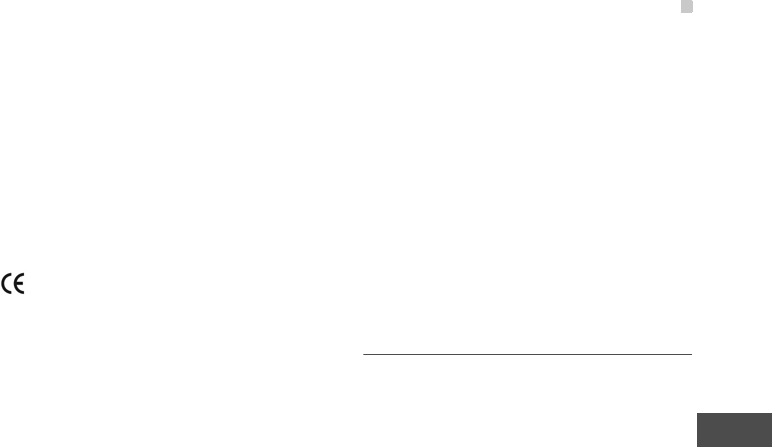
Certification Information (SAR)
71
15
Warnings and Precautions
metal part. Use of other accessories may not ensure
compliance with FCC RF exposure guidelines.
The SAR limit adopted by the USA and Canada is 1.6
watts/kilogram (W/kg) averaged over one gram of tis-
sue. The highest SAR value reported to the FCC and
IC for this device type when tested for use at the ear
is 1.3 W/kg, and when properly worn on the body is
1.05 W/kg.
This device complies with Part 15 of the FCC Rules.
Operation is subject to the condition that this device
does not cause harmful interference.
EU Declaration of Conformity
according to the Radio Equipment and Telecommuni-
cations Terminal Equipment Directive 1999/5/EC
For the following equipment
Product: WCDMA/GPRS/GSM Mobile Phone
Type Designation/Trademark: HUAWEI/U1215
Manufacturer's Name: Huawei Technologies Co.,Ltd.
Manufacturer's Address: Bantian, Longgang District,
Shenzhen, 518129, Guangdong, P. R. China.
is herewith confirmed to comply with the require-
ments set out in the Council Directive1999/5/EC for
radio equipment and telecommunications terminal
equipment. For the evaluation of the compliance with
this Directive, the following standards were applied:
Safety: EN 60950-1:2001 First Edition;
Health: EN 50360:2001; EN 50361:2001;
EMC: EN 301 489-1 V1.4.1; EN 301 489-24 V1.2.1;
EN 301489-7 1.2.1; EN 301489-17 1.2.1;
Radio: EN 301 511 V9.0.2; EN 301 908-1 V2.2.1; EN
301 908-2 V2.2.1; EN 300 328 V1.4.1;
Responsible for making this declaration is the: Manu-
facturer.
FCC Statement
This equipment has been tested and found to comply
with the limits for a Class B digital device, pursuant to
Part 15 of the FCC Rules. These limits are designed
to provide reasonable protection against harmful
interference in a residential installation. This equip-
ment generates, uses and can radiate radio fre-
U121.book Page 71 Friday, October 19, 2007 10:40 AM

Certification Information (SAR)
72
quency energy and, if not installed and used in
accordance with the instructions, may cause harmful
interference to radio communications. However,
there is no guarantee that interference will not occur
in a particular installation. If this equipment does
cause harmful interference to radio or television
reception, which can be determined by turning the
equipment off and on, the user is encouraged to try to
correct the interference by one or more of the follow-
ing measures:
• Reorient or relocate the receiving antenna.
• Increase the separation between the equipment
and receiver.
• Connect the equipment into an outlet on a circuit
different from that to which the receiver is con-
nected.
• Consult the dealer or an experienced radio/TV
technician for help.
This device complies with Part 15 of the FCC Rules
and with RSS-210 of Industry Canada.
Operation is subject to the following two conditions:
(1) This device may not cause harmful interference,
and
(2) This device must accept any interference
received, including interference that may cause
undesired operation.
Warning: Changes or modifications made to this
equipment not expressly approved by HUAWEI may
void the FCC authorization to operate this equipment.
U121.book Page 72 Friday, October 19, 2007 10:40 AM
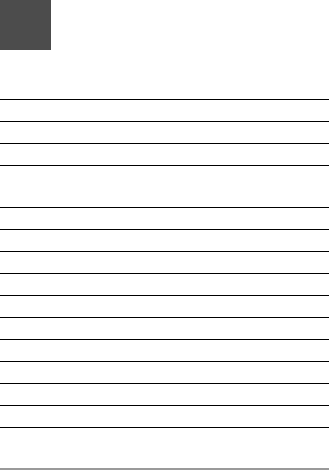
73
16Acronyms and Abbreviations
DCF DRM Content Format
DRM Digital Rights Management
FDN Fixed Dial Number
GPRS General Packet Radio Service
GSM Global System for Mobile communica-
tion
OTA Over-The-Air
PIN Personal Identification Number
PLMN Public Land Mobile Network
PUK PIN Unblocking Key
SD Secure Digital Card
SAR Specific Absorption Rate
STK SIM Tool Kit
URL Universal Resource Locator
USB Universal Serial Bus
WAP Wireless Application Protocol
WCDMA Wideband Code Division Multiple
Access
U121.book Page 73 Friday, October 19, 2007 10:40 AM

74
17Appendix
The phone supports image files, video files and audio
files of many formats. For details, see the following
table.
Note
In some cases, the preceding media for-
mats may not be supported.
File type Formats
Image JPG, PNG, BMP, GIF, BCI, WBMP, SVG,
and SVGZ.
Audio MP3, AAC/AAC+, AMR, MID, WAV
(ADPCM), MMF, QCP, and XMF/DLS.
Video 3GP, MP4, 3G2, and PMD.
U121.book Page 74 Friday, October 19, 2007 10:40 AM

1
"123" Numeric Input Method .................................. 16
Access Codes ........................................................ 10
Accessing the Internet by USB .............................. 54
Adding/Deleting Group Members........................... 19
Alarms.................................................................... 37
Answer mode ......................................................... 59
Answering or Rejecting Calls ................................. 11
Available Options of Games .................................. 46
Auto answer ........................................................... 59
Auto keypad lock.................................................... 57
Auto ON and OFF .................................................. 57
Auto redial .............................................................. 59
Back View ................................................................ 3
Battery.................................................................... 67
Bluetooth................................................................ 50
Bluetooth-Based Data Transfer ............................. 51
Bluetooth-Based Internet Access........................... 52
Bluetooth-Based Synchronisation.......................... 50
Bookmarks ............................................................. 45
Broadcast Inbox ..................................................... 34
Browser.................................................................. 44
Browsing Pre-set Web Pages ................................ 44
Calculator ............................................................... 40
Calendar Functions................................................ 38
Calendar ................................................................ 37
Call barring password ............................................ 60
Call barring............................................................. 58
Call forwarding ....................................................... 58
Call settings ........................................................... 58
Call waiting ............................................................ 59
Calling ID ............................................................... 60
Camera .................................................................. 46
Certification Information (SAR).............................. 69
Change password.................................................. 62
Charger.................................................................. 68
Charging the Battery................................................ 7
Charging with a Cable Charger ............................... 7
Children Safety ...................................................... 65
Cleaning and Maintenance.................................... 66
Common Phrases .................................................. 34
Connectivity ........................................................... 61
Creating a Multimedia Message ............................ 25
Creating a Text Message ...................................... 22
Creating an Email .................................................. 29
Currency converter ................................................ 41
Date and time ........................................................ 56
Date format............................................................ 56
Display settings ..................................................... 57
DRM Setting .......................................................... 63
Electronic Device................................................... 64
Email Settings........................................................ 32
Email...................................................................... 29
Emergency Calls ................................................... 67
Enter URL.............................................................. 44
Environmental Protection ...................................... 67
FCC Statement...................................................... 71
Fixed dialer number............................................... 63
FM Radio ............................................................... 48
Index
U121.book Page 1 Friday, October 19, 2007 10:40 AM
2
Function Options During Playing ........................... 35
Games ................................................................... 46
Groups ................................................................... 19
Home Screen ........................................................... 3
Hospital .................................................................. 64
Icon Description ..................................................... 12
Icon Description ..................................................... 13
Input Different Languages...................................... 17
Input language ...................................................... 56
Internet Settings..................................................... 45
Introduction to the Menu .......................................... 4
Keypad lock period ................................................ 57
Loading the Battery.................................................. 6
Loading/Removing a Memory Card ......................... 9
Loading/Removing the SIM Card............................. 8
Mailboxes............................................................... 29
Making a Video Call ............................................... 11
Making a Voice Call ............................................... 11
Making Calls from Call Log .................................... 21
Making Calls from the Contacts ............................. 18
Making or Answering Calls .................................... 11
Making Voice Calls Using SDN.............................. 11
Managing a Group ................................................. 20
Memo .................................................................... 39
Message settings ................................................... 58
micro-SD Card Reader .......................................... 55
MMS Mailboxes ..................................................... 26
MMS Settings......................................................... 28
Multimedia Messages ............................................ 25
Music ..................................................................... 48
My music ............................................................... 35
My number............................................................. 60
Network ................................................................ 61
New Schedule ....................................................... 38
New Tasks............................................................. 39
Operating Environment.......................................... 66
Operations After Taking a Picture ......................... 47
Operations During a Video Call ............................ 13
Operations During a Voice Call ............................. 12
Operations During Recording ................................ 48
Operations in the Viewfinder Screen ..................... 46
Operations in the Viewfinder Screen ..................... 47
Operations ............................................................. 12
Operations ............................................................. 13
Other Operations for the Homepage ..................... 44
Other Operations ................................................... 19
Other Operations ................................................... 21
Packing List ............................................................. 1
Password lock ....................................................... 62
Phone language ................................................... 56
Phone settings....................................................... 56
Playlist ................................................................... 36
Powering Off .......................................................... 10
Powering On............................................................ 9
Powering On/Off ...................................................... 9
Profiles................................................................... 56
Prompt Interface for a Schedule............................ 38
Prompt Interface for a Task ................................... 39
U121.book Page 2 Friday, October 19, 2007 10:40 AM

3
Prompt Interface for an Alarm ................................ 37
Prompt to save....................................................... 60
Push Inbox Settings ............................................... 33
Push Inbox ............................................................. 33
Reset...................................................................... 62
Screen Operations During Playing......................... 35
Searching for a Contact ......................................... 18
Security .................................................................. 61
Select line .............................................................. 60
Service dial number ............................................... 42
Setting Alarm Clocks.............................................. 37
Shortcuts ................................................................ 57
Side View ................................................................ 3
SIM ToolKit ............................................................ 37
SMS Mailboxes ...................................................... 22
SMS Settings ......................................................... 24
Stopping the Alarm Clock ...................................... 37
Stopwatch .............................................................. 42
Storage Environment ............................................. 65
Symbol Input Method ............................................. 16
Synchronise ........................................................... 39
T9 Input Method..................................................... 15
Task ....................................................................... 39
Tasks Functions ................................................... 39
Text Messages....................................................... 22
The Bluetooth Headset .......................................... 51
Timer...................................................................... 42
Traditional Input Method ....................................... 16
Video call .............................................................. 61
Video Camera........................................................ 47
Viewing Push Messages ....................................... 33
Unit converter ........................................................ 41
Unloading the Battery .............................................. 6
Voice Mail number ................................................. 34
Voice recorder ....................................................... 41
World Time ............................................................ 42
USB ....................................................................... 53
USB-Based Synchronisation ................................. 54
Using the USB Cable............................................. 69
Your Phone.............................................................. 2
U121.book Page 3 Friday, October 19, 2007 10:40 AM